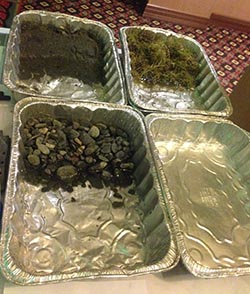By LISA MATLOCK
Outreach Coordinator
During the summer of 2012, the council hosted a workshop with environmental education professionals from all over Southcentral Alaska, pooling the best oil spill education programs in one place. Katie Gavenus, an environmental educator from Homer, was chosen by the council’s Information and Education Committee to put new activity ideas and the best of the original curriculum together. The resulting 2014 K-12 Oil Spill Curriculum will help today’s students understand the history and science of oil spills in Alaska.

The students, working in teams, plan how they will respond to the vegetable oil and black tempura paint oil spill that is about to hit.
Cost sheets describe how much their labor and available oil spill response materials – such as pipe cleaners, cotton balls, sponges, and oil absorbent pads – will cost and what is their budget for the clean-up. Once they signal they are ready, a teaspoon of the oil mixture is spilled into their pan, and they race to respond. In a short and exciting hour, these students understand more about oil spill response, and the importance of oil spill prevention, than most adults.
In 1990, Beth Trowbridge, an educator at the Prince William Sound Science Center, wrote the original K-12 Oil Spill Curriculum. This curriculum was developed for students in the Exxon Valdez oil spill area to learn about, and cope with, the effects the spill had on their families and communities. Trowbridge, now executive director of the Center for Alaskan Coastal Studies, was instrumental in revising the curriculum over time.
Today, the average 4th grader does not know much, if anything, about the Exxon Valdez oil spill. The council, in partnership with Gavenus, wanted this new version to reflect the perspective of K-12 students with no personal experience of an oil spill. Thus, the current curriculum focuses on student understanding of our marine environment and how capable we are to prevent and respond to oil spills. Gavenus completed the new version of the curriculum this past winter, making sure it meets Alaska’s state standards. The lessons follow two tracks, “Oil Resources and Energy Cycles” and “Ecosystems and Oil Pollution.”
The first test of new lessons was led by board member, Patience Andersen Faulkner, and myself for Tatitlek students last May. The kids in the school had heard stories of the Exxon Valdez oil spill from family, but for most of them this was the first time they explored how an oil spill could affect them, their community, and the wildlife in the area. Pilot lessons continued this fall with Gavenus leading lessons in Homer, Seward, Whittier, Tatitlek, and Chenega Bay. Teachers in these classrooms are being surveyed, so the curriculum can be regularly reviewed and modified to reflect best practices.
“In Homer, students took on the ‘oil spill in a pan’ clean up challenge with great gusto,” said Gavenus. “Most were frustrated by how difficult it was to clean up the oil, recognizing the importance of preventing a spill in the first place. But amidst the frustration, great ideas were born. Perhaps, one day, they will develop a real-life technology based on the insights they gained through this experience.”
Outreach for the newly revised K-12 Oil Spill Curriculum will continue this spring on Kodiak Island and beyond. In October, the council has also proposed to share the curriculum with teachers state-wide at the bi-annual Alaska Math and Science Conference in Sitka. And the council, along with its partners, will continue to share lessons of the curriculum with teachers and classrooms all over the region each year. Oil spills in the classroom help spread the message of oil spill prevention to the next generation, a goal that is very important to the council.
The curriculum is available on our education section: Alaska Oil Spill Curriculum